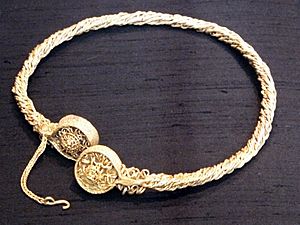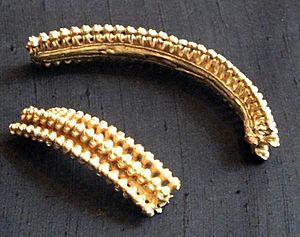Stirling torcs facts for kids
The Stirling torcs are a collection of four amazing gold necklaces, called torcs, from the Iron Age. These special necklaces were made between 300 and 100 BC. Someone buried them on purpose a very long time ago.
A person using a metal detector found them in a field near Blair Drummond, Stirlingshire, Scotland. This happened on September 28, 2009. Experts say this find is the most important discovery of Iron Age metal items in Scotland. It is also important around the world. The torcs were valued at £462,000. After people helped raise money, the torcs were bought by the National Museums Scotland in March 2011.
Contents
How the Torcs Were Found
A new metal detector user named David Booth found the torcs. It was his very first time looking for treasure. He was using a simple metal detector. David found a good spot and got permission from the landowner to search there.
He said, "I parked up and got the metal detector out. There was an area of flat ground behind the car, and I thought, I’ll just scan this first, before I head out into the field. Literally about seven steps behind where I had parked, I found them."
David took the torcs home and cleaned them. He looked them up online and then filled out a form for the Scottish Treasure Trove website. He also sent a photo to the Scottish Treasure Trove Unit. Dr Fraser Hunter, an expert, was very surprised when he saw the pictures. Museum staff arrived at the site just a few hours later. They dug up the area and found parts of an old wooden roundhouse. However, they did not find any more items.
What Are the Stirling Torcs?
All four torcs were buried together about 6 to 8 inches (15–20 cm) deep. Later, archaeologists found that the torcs were buried inside a roundhouse. This old circular building might have been a special place. Sometimes, valuable items like these were buried as gifts to gods. Other times, people hid them during times of trouble or war. This building did not seem to be a normal home.
All four torcs were made between 300 and 100 BC. They look very different from each other, which makes the find even more special.
Different Types of Torcs
Two of the torcs are called "twisted ribbon torcs." They are in perfect condition. These are simple and elegant. They were made from a flat strip of gold that was twisted. This style of jewelry was common in Scotland and Ireland. It goes back to the Late Bronze Age. One of these torcs has plain hooked ends. The other has more decorative disc ends.
The third torc is broken into two pieces. It is a tubular torc that would have had a hinge and a clasp. This one is much fancier than the ribbon torcs. Experts believe it came from the Toulouse area in southern France. This is the first time this type of torc has been found in Britain.
The fourth torc is complete and in good shape. It is made from eight gold wires twisted together. It has very detailed ends and a short safety chain. Dr Fraser Hunter, an expert at the National Museum of Scotland, said this torc is a mix of styles. It shows both Mediterranean craftsmanship and older Iron Age designs. This torc might have been made for a local leader by someone who learned their skills in the Mediterranean region. This, along with the third torc, suggests that Scotland had important connections with Southern Europe a long time ago.
After the Discovery
After the archaeologists finished their work, the torcs were shown to the public on November 4, 2009. David Booth and museum staff presented them in Edinburgh.
In Scotland, old items found in the ground belong to the Crown (the government). People who find them must report them. David Booth was given a reward equal to the value of the torcs. Experts said the torcs would definitely stay in Scotland. In October 2010, the torcs were valued at £462,000. The Crown decided to give the torcs to the National Museums Scotland. But the museum had to pay £462,000 to David Booth. The museum had until April 2011 to raise this money.
By March 2011, the money was raised. Many people helped, and large grants came from the Art Fund and the National Heritage Memorial Fund. This allowed the museum to buy the torcs.
Images for kids









